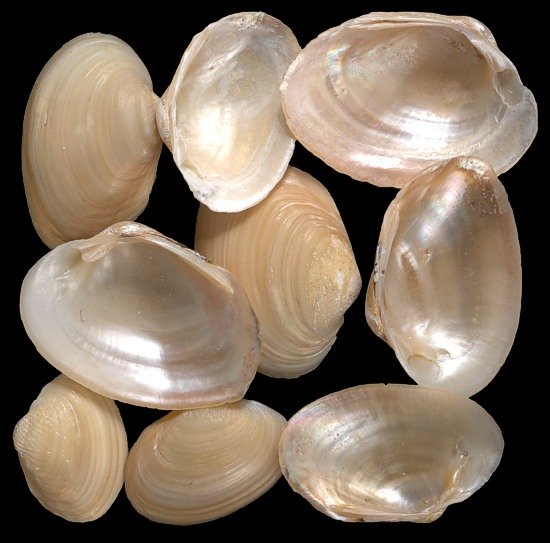As the site is updated, each listing includes the shipping cost. Some listings which I have not updated still give you calculated shipping costs based on weight and size of package. (In the sections I have updated) If you select several different listings, we will consolidate your order and charge you the actual cost of the entire package. The shipping over charge will be refunded to you, when your order is shipped.
JINGLE SHELLS ARE POPULAR SHINY SCALLOPS

Anomia simplex, the common name Jingle Shell
Anomia simplex is a species of the bivalve mollusk in the family of Anomiidae, similar to blue mussels, American oysters, and bay scallops. The family of Anomiidae ranges from saltwater clams to bivalve mollusks, which contains about 7 genera, including Anomia simplex. Anomiids are most closely recognized for their extremely thin, often translucent, paper-like shells, which can often be used to help manufacture glue, chalk, paints, and other materials. Jingle Shells are very strong and withstand many environmental pressures on hard substrates.
(REF:"Jingle Shell". www.edc.uri.edu ) (REF: "Long Beach Island | Anomia simplex". www.longbeachislandjournal.com)
Anomia simplex have often been referred to as common jingle shells, gold shells, and even Mermaid’s Toenails. The origin of the nickname common jingle shell refers to the sound a collection or grouping of these shells will make when carried in a container and mixed around, producing a jingle.
Anomia simplex shells commonly grow to 1 to 3 inches and are noted for the differences between the upper and lower valves of their bivalve conformation. The lower valve of Anomia simplex remains an off-white color, the upper valve can range from shiny lemon yellow, golden, brown, silvery black, and pale buff. The iridescence of these common bivalve mollusks remains well after death. Common Jingle shells are very thin and their shells can range from roughly circular to oval-shaped. The shell is often translucent, smooth, and displays various growth lines that can mirror the substrate on which they lived.
(REF: Scientist, Beach Chair (2012-12-05). "Jingle shells, jingle shells, jingle all the way". Beach Chair Scientist)
Anomia simplex are found throughout the year in shallow waters: estuaries, bays, or beaches, from the low tide water line all the way up to 30 feet deep. Common Jingle shells are found coexisting in oyster beds and mollusk shells as far north as the coast of Nova Scotia, and as far south as the coast of Brazil.
These bivalve mollusks attach themselves to hard objects in the water for structure, which can be other shells such as oyster beds and mollusk shells, or hard substrates such as a rock. The lower valve is responsible for anchoring the bivalve mollusk onto the substrate, in which it will spend the majority of its lifetime as a filter feeder.
Anomia simplex are species of bivalve mollusks in which each valve is responsible for a set of specific tasks. The upper valve is convex and movable, often contributing to the filter-feeding quality of Anomia simplex which is achieved through their ciliated gills. The lower valve is concave and matches the curvature and irregularities of the hard substrate it has attached. Threads or finger-like projections, called byssus, are known for attaching themselves to an object, which protrude from the top of the lower valve through a extruded hole.
The process of anchoring to a hard substrate can be described as metamorphosis or settling, including a larval stage and ultimately leading to an anchored bivalve mollusk configuration. The Anomia simplex larvae maturing and approaching metamorphosis drop to the bottom of shallow waters, and begin crawling through the use of a strong foot in order to find a hard substrate. Once the suitable substrate is found, the larvae bind to the structure through byssus filaments, which will then be calcified meaning a permanent bond is formed. The anomia simplex will end metamorphosis by the development of well-structured gills, which aid in food absorption by the mollusk and will be the primary source of nutrients for the remainder of the lifetime of Anomia simplex.
(REF: Scientist, Beach Chair (2012-12-05). "Jingle shells, jingle shells, jingle all the way". Beach Chair Scientist)
Scientific Classification
Domain: Eukaryota
Kingdom: Animalia
Phylum: Mollusca
Class: Bivalvia
Order: Pectinida
Family: Anomiidae
Genus: Anomia
Species: A. simplex
Binomial name: Anomia Simplex
Orbigny, 1842
J0-8
One quarter pound of single Jingle Shells, no matching pairs, measuring 1 to 2 inches....... $8.95
xJ0-8
One half pound of single Jingle Shells, no matching pairs, measuring 1 to 2 inches....... $13.95
xxJ0-8
One pound of single Jingle Shells, no matching pairs, measuring 1 to 2 inches....... $15.95
J1-8
One quarter pound of single Jingle Shells, no matching pairs, measuring 2 to 3 inches....... $8.75
xJ1-8
One half pound of single Jingle Shells, no matching pairs, measuring 2 to 3 inches....... $14.95